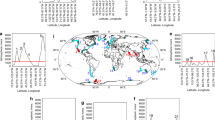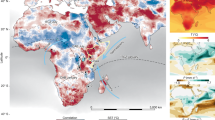Abstract
Observations and climate change projections forced by greenhouse gas emissions have indicated a wetting trend in northern high latitudes, evidenced by increasing Eurasian Arctic river discharges1,2,3. The increase in river discharge has accelerated in the latest decade and an unprecedented, record high discharge occurred in 2007 along with an extreme loss of Arctic summer sea-ice cover4,5,6. Studies have ascribed this increasing discharge to various factors attributable to local global warming effects, including intensifying precipitation minus evaporation, thawing permafrost, increasing greenness and reduced plant transpiration7,8,9,10,11. However, no agreement has been reached and causal physical processes remain unclear. Here we show that enhancement of poleward atmospheric moisture transport (AMT) decisively contributes to increased Eurasian Arctic river discharges. Net AMT into the Eurasian Arctic river basins captures 98% of the gauged climatological river discharges. The trend of 2.6% net AMT increase per decade accounts well for the 1.8% per decade increase in gauged discharges and also suggests an increase in underlying soil moisture. A radical shift of the atmospheric circulation pattern induced an unusually large AMT and warm surface in 2006–2007 over Eurasia, resulting in the record high discharge.
This is a preview of subscription content, access via your institution
Access options
Subscribe to this journal
Receive 12 print issues and online access
$209.00 per year
only $17.42 per issue
Buy this article
- Purchase on Springer Link
- Instant access to full article PDF
Prices may be subject to local taxes which are calculated during checkout



Similar content being viewed by others
References
Peterson, B. J. et al. Increasing river discharge to the Arctic Ocean. Science 298, 2171–2173 (2002).
Wu, P., Wood, R. & Stott, P. Human influence on increasing Arctic river discharges. Geophys. Res. Lett. 32, L02703 (2005).
Kattsov, V., Walsh, J. E., Govorkova, V., Pavlova, T. & Zhang, X. Arctic Ocean freshwater budget components in simulations with the IPCC AR4 AOGCMs. J. Hydrometeorol. 8, 571–589 (2007).
Comiso, J. C., Parkinson, C. L., Gersten, R. & Stocket, L. Accelerated decline in the Arctic sea ice cover. Geophys. Res. Lett. 35, L01703 (2008).
Zhang, X., Sorteberg, A., Zhang, J., Gerdes, R. & Comiso, J. C. Recent radical shifts of atmospheric circulations and rapid changes in Arctic climate system. Geophys. Res. Lett. 35, L22701 (2008).
Shiklomanov, A. I. & Lammers, R. B. Record Russian river discharge in 2007 and the limits of analysis. Environ. Res. Lett. 4, 045015 (2009).
Zhang, X. et al. Detection of human influence on twentieth-century precipitation trends. Nature 448, 461–465 (2007).
Oelke, C., Zhang, T. & Serreze, M. C. Modeling evidence for recent warming of the Arctic soil thermal regime. Geophys. Res. Lett. 31, L07208 (2004).
Zhang, J. & Walsh, J. E. Thermodynamic and hydrological impacts of increasing greenness in northern high latitudes. J. Hydrometeorol. 7, 1147–1163 (2006).
Zhang, J. & Walsh, J. E. Relative impacts of vegetation coverage and leaf area index on climate change in a greener north. Geophys. Res. Lett. 34, L15703 (2007).
Betts, R. A. et al. Projected increase in continental runoff due to plant responses to increasing carbon dioxide. Nature 448, 1037–1042 (2007).
Wentz, F. J. & Schabel, M. Precise climate monitoring using complementary satellite data sets. Nature 403, 414–416 (2000).
Held, I. M. & Soden, B. J. Robust responses of the hydrological cycle to global warming. J. Clim. 19, 5686–5699 (2006).
Pavelsky, T. M. & Smith, L. C. Intercomparison of four global precipitation data sets and their correlation with increased Eurasian river discharge to the Arctic Ocean. J. Geophys. Res. 111, D21112 (2006).
Serreze, M. et al. Large-scale hydro-climatology of the terrestrial Arctic drainage system. J. Geophys. Res. 108, 8160 (2003).
McClelland, J. W., Holmes, R. M., Peterson, B. J. & Stieglitz, M. Increasing river discharge in the Eurasian Arctic: Consideration of dams, permafrost thaw, and fires as potential agents of change. J. Geophys. Res. 109, D18102 (2004).
Dai, A., Qian, T., Trenberth, K. E. & Milliman, J. D. Changes in continental freshwater discharge from 1948 to 2004. J. Clim. 22, 2773–2792 (2009).
Yang, D., Kane, D., Zhang, Z., Legates, D. & Goodison, B. Bias corrections of long-term (1973–2004) daily precipitation data over the northern regions. Geophys. Res. Lett. 32, L19501 (2005).
Thompson, D. W. J. & Wallace, J. M. The Arctic oscillation signature in the wintertime geopotential height and temperature fields. Geophys. Res. Lett. 25, 1297–1300 (1998).
Kistler, R. et al. The NCEP–NCAR 50–year reanalysis: Monthly means CD–ROM and documentation. Bull. Am. Meteorol. Soc. 82, 247–268 (2001).
Trenberth, K. E. Climate diagnostics from global analyses: Conservation of mass in ECMWF analyses. J. Clim. 4, 707–722 (1991).
Ebisuzaki, W. A method to estimate the statistical significance of a correlation when the data are serially correlated. J. Clim. 10, 2417–2153 (1997).
Polyakov, I. et al. Variability and trends of air temperature and pressure in the maritime Arctic, 1875–2000. J. Clim. 16, 2067–2077 (2003).
Overland, J. E., Spillane, M. C., Percival, D. B., Wang, M. & Mofjeld, H. O. Seasonal and regional variation of pan-Arctic surface air temperature over the instrumental record. J. Clim. 17, 3263–3282 (2004).
Muskett, R. R. & Romanovsky, V. Groundwater storage changes in arctic permafrost watersheds from GRACE and in situ measurements. Environ. Res. Lett. 4, 045009 (2009).
Rawlins, M. A., Serreze, M. C., Schroeder, R., Zhang, X. & McDonald, K. C. Diagnosis of the record discharge of Arctic-draining Eurasian rivers in 2007. Environ. Res. Lett. 4, 045011 (2009).
Zhang, X., Walsh, J. E., Zhang, J., Bhatt, U. S. & Ikeda, M. Climatology and interannual variability of Arctic cyclone activity, 1948–2002. J. Clim. 17, 2300–2317 (2004).
Jarraud, M. & Simmons, A. J. Proc.1983 ECMWF Seminar on Numerical Methods for Weather Prediction, Vol. II, 1–60 (Reading, ECMWF, 1983).
Jones, P. W. First- and second-order conservative remapping schemes for grids in spherical coordinates. Mon. Weath. Rev. 127, 2204–2210 (1999).
Vorosmarty, C. J., Fekete, B. M., Meybeck, M. & Lammers, R. B. Geomorphometric attributes of the global system of rivers at 30-minute spatial resolution. J. Hydrol. 237, 17–39 (2000).
Acknowledgements
We are grateful to J. E. Walsh for comments that have improved the content and presentation of this paper. We also thank C. Stephenson for his assistance in preparing Fig. 1. The NOAA-ESRL Physical Sciences Division made the NCEP–NCAR reanalysis data available online. The Arctic Region Supercomputing Center supplied computational resources. This work was supported by the US National Science Foundation, the Japan Agency for Marine-Earth Science and Technology and the Joint DECC/Defra Met Office Hadley Centre Climate Programme.
Author information
Authors and Affiliations
Contributions
X.Z. designed the research, analysed data, wrote the paper and participated in computation and figure plotting. J.H. conducted computation and figure plotting. J.Z. participated in computation and figure plotting. J.H., J.Z., I.P., R.G., J.I. and P.W. contributed to data analysis and paper writing.
Corresponding author
Ethics declarations
Competing interests
The authors declare no competing financial interests.
Supplementary information
Supplementary Information
Supplementary Information (PDF 1976 kb)
Rights and permissions
About this article
Cite this article
Zhang, X., He, J., Zhang, J. et al. Enhanced poleward moisture transport and amplified northern high-latitude wetting trend. Nature Clim Change 3, 47–51 (2013). https://doi.org/10.1038/nclimate1631
Received:
Accepted:
Published:
Issue Date:
DOI: https://doi.org/10.1038/nclimate1631
This article is cited by
-
Important role of stratosphere-troposphere coupling in the Arctic mid-to-upper tropospheric warming in response to sea-ice loss
npj Climate and Atmospheric Science (2023)
-
Arctic cyclones have become more intense and longer-lived over the past seven decades
Communications Earth & Environment (2023)
-
Preface to the Special Issue on Changing Arctic Climate and Low/Mid-latitudes Connections
Advances in Atmospheric Sciences (2023)
-
Enhanced Arctic sea ice melting controlled by larger heat discharge of mid-Holocene rivers
Nature Communications (2022)
-
Decadal changes of wintertime poleward heat and moisture transport associated with the amplified Arctic warming
Climate Dynamics (2022)



